Exploring Libyan Desert Glass: A Geological Marvel
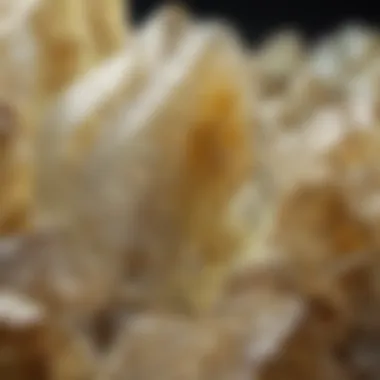
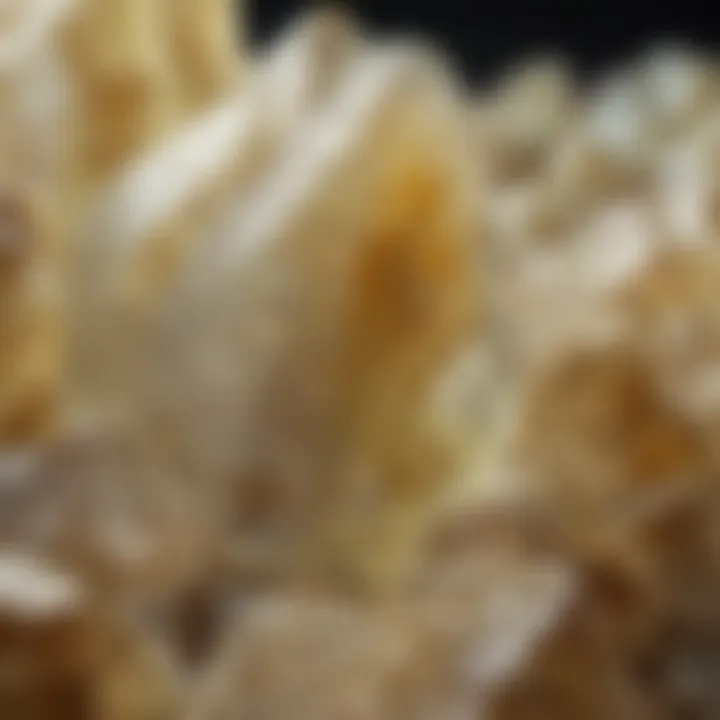
Intro
Libyan Desert Glass, also known as Libyan Gold, stands out as a natural glass with remarkable properties. This unique substance, found in the vast expanses of the Sahara Desert, has intrigued both scientists and collectors due to its unusual yellowish color and fascinating origins. This article aims to provide an in-depth exploration of Libyan Desert Glass, shedding light on its geological formation, physical characteristics, and relevance in the fields of archaeology and modern applications.
The journey through this natural wonder encompasses a variety of perspectives, including its formation theories, collection methods, and preservation techniques. The aim is to equip enthusiasts and scholars alike with an understanding of this fascinating material.
Featured Collectible of the Month
Overview
Libyan Desert Glass is not just a collectible item; it is a geological marvel that captures the essence of Earth's natural processes. This glass is believed to have formed as a result of a meteorite impact, although there are other competing theories. Found primarily in the Libyan Desert, its bright yellow hue and smooth texture make it both visually striking and desirable for collectors. Those who seek it out find that its rarity and distinctive appearance add a valuable touch to their collections.
Historical Significance
The intriguing properties of Libyan Desert Glass have drawn interest from historians and archaeologists alike. Artifacts made from this glass have been dated back to ancient Egypt, where it was likely prized for its beauty and perceived magical properties. This glass was used in amulets and jewelry, reflecting its importance in both trade and cultural practices. Understanding its historical context enriches collectors' appreciation for the material, linking them to a narrative that spans millennia.
Identification Techniques
Visual Characteristics
Identifying Libyan Desert Glass requires attention to specific visual features. Collectors should look for:
- Color: Typically a yellow to amber hue, sometimes with greenish tints.
- Transparency: The glass can vary from transparent to translucent.
- Inclusions: Natural inclusions like bubbles or tiny minerals can be present, adding character.
These characteristics play a crucial role in distinguishing genuine Libyan Desert Glass from imitators.
Resources for Identification
For collectors looking to authenticate their finds, several resources are available. These include:
- The Gemological Institute of America (GIA), which offers education on gemstone identification.
- Online forums like those on Reddit, where collectors share insights and experience.
- Books on natural minerals and glass work, which provide detailed descriptions.
Additionally, local gem and mineral shows often feature experts who can assist with identification and evaluation. Collectors are encouraged to take part in these communities to enhance their knowledge and understanding of this unique material.
"Libyan Desert Glass is not merely a collectible; it is a window into Earth’s dynamic processes and human history."
This exploration of Libyan Desert Glass is just the beginning. As we go deeper into its geological properties and contemporary uses, readers will gain a thorough understanding of why this glass continues to captivate the world.
Intro to Libyan Desert Glass
Libyan Desert Glass is a fascinating natural glass found primarily in the Sahara Desert region. Its unique formation and distinctive characteristics make it an object of interest not only for collectors but also for scientists studying geological processes. This section serves to lay the groundwork for understanding the significance of Libyan Desert Glass within the broader context of geology and archaeology. The subsequent exploration of its origins, physical properties, and uses will further highlight its remarkable qualities.
Overview of Natural Glass
Natural glass is formed through natural processes that involve extreme heat and pressure. Common types of natural glass include obsidian, tektites, and, of course, Libyan Desert Glass. Each type has unique characteristics based on its formation process. Libyan Desert Glass, in particular, is notable for its golden-yellow hue and smooth texture, which distinguishes it from other forms of natural glass.
This glass is primarily found in specific regions of the Sahara, covering areas of Libya and Egypt. The geological conditions contributing to its formation are fascinating, revealing a brief history of Earth's tumultuous events.
Significance in Geology
In geology, Libyan Desert Glass offers essential insights into the processes that shape our planet. Its formation is linked to events of significant impact, which could have occurred millions of years ago. Such natural phenomena can lead to temperature increases that melt silica components in surrounding materials, resulting in the creation of glass-like substances. Studying Libyan Desert Glass helps researchers understand chronological developments within the Earth's crust and the ramifications of such events on the surrounding environment.
"Understanding natural glass not only aids geological studies but provides clues about Earth's past and its dynamic systems."
The significance of Libyan Desert Glass also extends to its rarity. Being a localized phenomenon, it provides valuable data for assessing both regional and global geological processes. The study of this natural glass can foster advances in the understanding of how similar materials are formed in other parts of the world. Moreover, the distinctiveness of Libyan Desert Glass encourages ongoing research into its physical and chemical properties, presenting opportunities for technological applications.
Thus, the significance of Libyan Desert Glass is multifaceted, bridging the gap between geology and practical applications while captivating collectors and scholars alike.
Geological Origins of Libyan Desert Glass
The Geological Origins of Libyan Desert Glass is a critical topic in understanding this unique natural resource. It sets the stage for exploring how this glass formed, what processes contributed to its creation, and appreciates its significance in both scientific study and collection. Knowledge of its origins illuminates the broader narrative of Earth's history, revealing processes that shaped not only the Libyan Desert but also the environment of our planet.
Formation Processes
Impact Theory
One prevailing theory concerning the formation of Libyan Desert Glass is the Impact Theory. This posits that the glass resulted from an intense meteorite impact. The heat generated during such events is known to melt silica-rich materials, which then cool and solidify into glass. This theory notably highlights the ability of impact events to create geological wonders and is popular among geologists because it ties closely to extraterrestrial phenomena. The key characteristic of this theory is the extreme conditions required for glass formation, including high pressure and temperature.
Among its advantages, the Impact Theory encapsulates a dramatic narrative, pointing to Earth's vulnerability to cosmic interactions. However, there are disadvantages: not all glass in the world originates from impact events, leading to debates about its universal applicability.
Volcanic Activity
Volcanic Activity is another significant contributor to the origins of Libyan Desert Glass. The theory suggests that the intense heat from volcanic eruptions can also produce natural glass. In continuous geological processes, lava may cool rapidly, leading to similar glass formations as found with meteorite impacts. This aspect of volcanic activity supports the idea that various geological forces can create similar materials, enriching the complexity of the Earth’s geology.
The key feature of volcanic activity is its ongoing nature, allowing for the possibility of discovering new formations over time. A primary benefit is its less rare occurrence compared to impacts. However, distinguishing volcanic glass from other types can pose challenges, making it sometimes difficult to ascertain specific origins based purely on observation.
Chemical Composition
The Chemical Composition of Libyan Desert Glass is central to understanding its formation and properties. The primary component is silica, but trace elements such as magnesium and aluminum add complexity to its characteristics. This distinctive makeup affects its color, clarity, and texture. Knowledge of its chemical arrangement aids in the classification and identification, which are essential for collectors and researchers alike.
The unique feature of the chemical aspect lies in its role during formation. Differences in the elemental makeup can provide vital clues about the conditions under which the glass formed. A significant advantage here is the fact that methodologies such as spectroscopy can analyze these compositions, enabling a more straightforward understanding of the glass’s properties. However, reliance on chemical composition may not always tell the full story of its geological history.
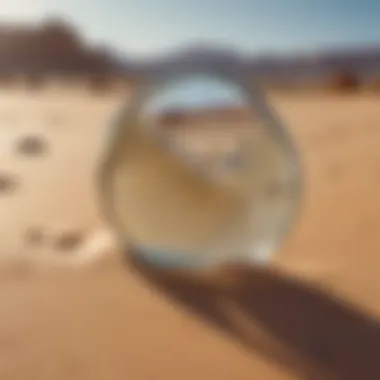
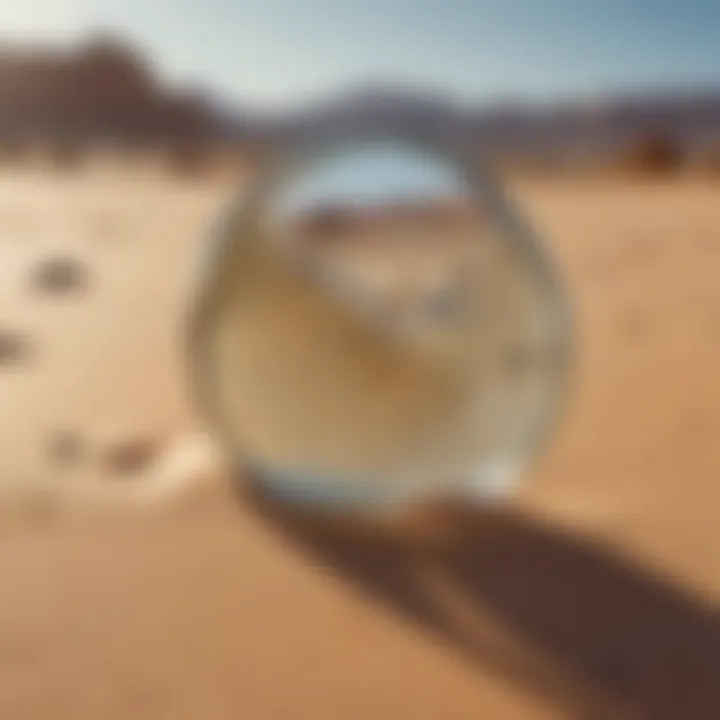
Dating and Age Determination
Radiometric Dating
Radiometric Dating is a cornerstone technique that allows for age determination of Libyan Desert Glass. It works under the principle of radioactive decay. By measuring the concentrations of certain isotopes within materials in or around the glass, researchers can estimate how long ago the glass was formed. Its primary advantage is the precision with which ages can be assigned, informing researchers about the geological timeline.
The key characteristic that makes radiometric dating beneficial is its quantitative nature, which can provide exact ages rather than vague estimates. However, it has limitations; if samples are contaminated or improperly collected, calculations can be skewed, raising challenges for accurate interpretation.
Stratigraphic Context
Considering the Stratigraphic Context is also essential for determining the age of Libyan Desert Glass. This approach assesses the layers of sediment surrounding the glass. By examining where the glass is located within the geological layers, scientists can infer its age relative to other geological events.
The main benefit of understanding stratigraphy helps researchers build a more thorough picture of geological history. Moreover, it connects Libyan Desert Glass to broader geological phenomena, enriching its narrative. However, this method requires precise excavation and context maintenance, which can be labor-intensive and sometimes risky, depending on the site conditions.
Physical Characteristics of Libyan Desert Glass
Understanding the physical characteristics of Libyan Desert Glass is crucial. These features not only affect its aesthetic appeal but also impact its significance in scientific study and collection practices. By recognizing these characteristics, enthusiasts can better appreciate the distinctiveness of this natural glass, leading to informed collection choices and preservation techniques.
Color Variations
Golden Yellow
Golden yellow is one of the most striking color variants of Libyan Desert Glass. This hue arises from specific chemical compositions during its formation. The yellow color is often favored for its vibrant appearance, making it a popular choice among collectors and jewellers. This unique feature provides a rich visual allure that sets it apart from other forms of glass. However, its intensity can vary, with deeper shades commanding higher interest.
Greenish Tones
The presence of greenish tones in Libyan Desert Glass adds to its diversity. These shades are indicative of the elemental composition and environmental conditions during its formation. Collectors appreciate these tones for their subtlety and variation. The unique aesthetic of greenish-hued glass increases its desirability. However, some individuals may prefer stronger colors, potentially limiting the appeal of this variant in certain markets.
Transparency Levels
Transparency levels play a pivotal role in the overall character of Libyan Desert Glass. While some pieces may be completely transparent, others might exhibit varying degrees of opacity. This characteristic can affect how light interacts with the glass, creating striking visual effects. Transparent specimens tend to be more sought after, as they allow for more intricate designs in jewelry and arts. However, those with lesser transparency may offer greater structural integrity and unique internal features.
Texture and Composition
Surface Roughness
Surface roughness of Libyan Desert Glass can vary greatly. A rough surface might indicate natural weathering or certain formation processes, giving a rough appearance and a texture that many find appealing. Collectors often seek out pieces with surface textures that are unusual or striking, as they can enhance the tactile experience. However, while rough surfaces may contribute to uniqueness, they can also present challenges in terms of care and cleaning.
Internal Structures
The internal structures of Libyan Desert Glass can reveal much about its formation history. Many specimens exhibit fascinating inclusions or gas bubbles that add depth to its scientific study. Such unique internal features are highly regarded by collectors and researchers alike. They not only enhance the beauty of the glass but also provide insights into geological processes. Recognizing and documenting these characteristics is essential for the proper identification and valuation of each piece.
Archaeological Significance of Libyan Desert Glass
Libyan Desert Glass, also known as Great Sand Sea glass, holds immense archaeological significance. This natural glass is not only unique in its geological formation but also in its historical applications. Understanding its usage by ancient cultures provides insight into human innovation and adaptation to environmental challenges. The study of this glass contributes to a broader understanding of the interplay between geology and human culture in North Africa.
Historical Uses
Tool Making
The use of Libyan Desert Glass in tool making highlights its practical applications in ancient societies. Ancient inhabitants of the region crafted sharp tools and blades from this glass, capitalizing on its hardness and ability to be finely honed. The key characteristic of these tools is their sharp edges, making them effective for cutting and scraping. This practical use shows how early humans exploited local resources to meet their needs.
- Advantages: The durability of the glass ensured that tools remained functional even under strenuous conditions. Moreover, the availability of Libyan Desert Glass in vast quantities allowed for a sustainable source of raw material for tool production.
- Disadvantages: However, the brittleness of glass posed challenges in terms of repair and longevity. Unlike stone tools that can often be reworked, glass tools are more prone to shattering.
Jewelry Crafting
Libyan Desert Glass has also been important in the realm of jewelry crafting. Ancient artisans utilized its striking appearance, often incorporating it into various adornments. The key characteristic of jewelry crafted from this glass is its aesthetic appeal, featuring colors ranging from a brilliant yellow to deep green nuances. This made it a popular choice among different cultures seeking decorative elements.
- Advantages: Jewelry made from Libyan Desert Glass is lightweight and offers stunning visual properties. It was often worn as status symbols, reflecting wealth and power among the ancient elite.
- Disadvantages: However, the inherent fragility of glass means that such pieces require careful handling to avoid breakage. This may have limited its usage to ceremonial or elite contexts rather than everyday wear.
Cultural Context
Ancient Civilizations
Libyan Desert Glass is fundamental in understanding the practices of ancient civilizations inhabiting the Sahara region. Archaeological evidence indicates that various cultures, such as the Egyptians, may have interacted with this material for both practical and symbolic purposes. The unique feature of these interactions lies in the geographical importance of the glass's source, linking cultures to trade routes and environmental adaptations.
- Advantages: Studying these civilizational effects enables historians and archaeologists to reconstruct trade networks and cultural exchanges across ancient Africa.
- Disadvantages: The sparse nature of archaeological records in desert regions can hinder comprehensive studies, making it challenging to pin down exact uses and significance.
Symbolic Importance
The symbolic importance of Libyan Desert Glass is notable as well. It was often associated with the divine or the powerful, believed to hold protective qualities. Cultures understood its rarity and, as such, revered objects made from this glass. The key characteristic is its perceived connection to celestial phenomena, linking the material to spiritual or mythological beliefs.
- Advantages: These beliefs add depth to our understanding of how cultures integrated natural resources into their spiritual life, reflecting a complex relationship with their environment.
- Disadvantages: However, the subjective nature of symbolism makes it difficult to assess universally agreed meanings, as interpretations vary widely across different cultures and time periods.
The archaeological significance of Libyan Desert Glass extends beyond its physical properties, revealing a tapestry of human culture, innovation, and belief.
In summary, the archaeological aspects of Libyan Desert Glass exemplify how a natural material can serve multifaceted roles in history. Its various applications in tool making and jewelry crafting underscore its significance in ancient societies while providing a window into the cultural contexts of those who valued it.
Collection Practices for Libyan Desert Glass
Collecting Libyan Desert Glass requires careful consideration. This section highlights ethical concerns, methods of finding, and tools essential for collection. Understanding these aspects is key for responsible harvesting and ensures the material's preservation for future study or enjoyment.
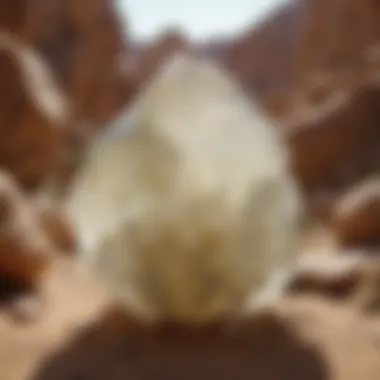
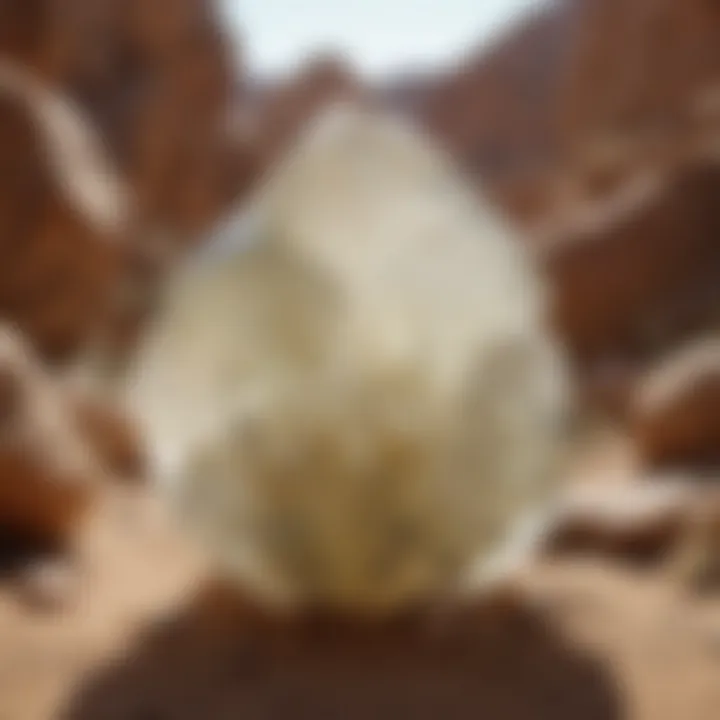
Ethical Considerations
Legal Aspects
The collection of Libyan Desert Glass is governed by specific legal frameworks. These laws vary by region and may dictate how, when, and where collection can occur. Adhering to these laws is crucial for ethical collection practices. This not only protects collectors from legal repercussions but also contributes to sustainable gathering practices.
Key laws often emphasize the need for permits in certain locations, particularly areas of archaeological significance. Being aware of these regulations can prevent the illegal collection of artifacts. Therefore, understanding the legal landscape enhances the integrity of collectors and encourages responsible behavior.
Environmental Impact
Collection activities can have various impacts on the environment. Collectors must be aware of potential disruptions to local ecosystems. The key characteristic of considering environmental impact focuses on preserving natural landscapes and minimizing human interference. Sustainable practices are a popular choice, as they help maintain biodiversity in areas where Libyan Desert Glass is found.
For instance, collecting responsibly may involve leaving certain areas undisturbed or using methods that do not disturb native flora and fauna. By prioritizing environmental care, collectors can enjoy their hobby without compromising the landscape’s ecological balance. This decision can have long-term advantages by ensuring that these environments remain healthy and accessible for future generations.
Methods of Finding and Extracting
Field Guides
Field guides are valuable tools for those interested in locating Libyan Desert Glass. These guides often provide detailed maps, descriptions, and tips for navigating specific regions. A well-constructed guide can greatly enhance the chances of successful finds, making it a beneficial choice for both novice and experienced collectors.
Unique features of comprehensive field guides include identification cues and seasonal advice on where to search for this natural glass. Their effectiveness can vary, but a good guide significantly increases the efficiency of treasure hunting efforts. Collectors should invest time in familiarizing themselves with these resources to optimize their search.
Tools Required
Proper tools are essential for the extraction of Libyan Desert Glass. Basic tools often include shovels, sieves, and small picks to carefully retrieve glass without causing harm to the surrounding area. These tools represent a critical aspect of collection practices, making the process more effective and less damaging.
The unique feature of using appropriate tools lies in ensuring minimal impact on the site. For example, lightweight and portable items are often favored because they are easier to carry and can be used in various terrains. The advantages of being well-equipped include a more rewarding collection experience and the preservation of the site's ecological balance.
In summary, understanding collection practices is vital for anyone interested in Libyan Desert Glass. This knowledge not only ensures legal compliance but also promotes environmental stewardship and enhances the overall collection experience.
Preservation and Care of Libyan Desert Glass
The preservation and care of Libyan Desert Glass play a crucial role in maintaining its integrity and beauty. As a natural artifact with historical and geological significance, proper handling and storage are essential for collectors and researchers alike. By focusing on the specific needs of this unique material, enthusiasts can ensure its longevity and aesthetic appeal.
Storage Conditions
Temperature Control
Temperature control is vital when storing Libyan Desert Glass. Exposure to high temperatures can potentially alter its physical properties, leading to glass degradation. By keeping the glass within a stable, moderate temperature range, one promotes its preservation.
A key characteristic of temperature management is consistency. Fluctuations can introduce stress within the material. This makes maintaining a constant environment a beneficial strategy for collectors. Furthermore, glass is sensitive to heat sources, and it is wise to avoid placing the glass near windows or heat vents. While extremely low temperatures are generally not harmful, sudden changes could cause cracks, negatively impacting the glass.
Humidity Management
Humidity management is also a significant aspect in preserving Libyan Desert Glass. Excess moisture can lead to surface deterioration, while extremely dry conditions can cause cracks to form. It is therefore crucial to aim for a relative humidity level between 40% and 60%.
A characteristic feature of humidity control is the use of silica gel packets or dehumidifiers in storage areas. These methods effectively reduce moisture levels, making them popular among collectors. However, over-drying can pose a unique challenge, leading to brittleness. Hence, striking a balance is essential for optimal preservation.
Cleaning Techniques
Gentle Methods
Cleaning Libyan Desert Glass should only be done using gentle methods. Abrasive materials or strong chemicals can easily damage its surface. Using a soft, lint-free cloth with lukewarm water is a recommended practice for collectors.
The primary reason gentle methods are beneficial is their capacity to protect the glass from scratches or cloudiness. Additionally, this approach helps maintain the glass's original shine. It is prudent to avoid scrubbing the surface too vigorously or using anything that could leave residue.
Avoiding Damage
When cleaning Libyan Desert Glass, avoiding damage is paramount. This involves not just using gentle techniques but also taking care during the handling process. One should always hold the glass with clean hands or wear cotton gloves to prevent oils from contacting the surface.
A unique feature of this approach is the recognition that prevention is easier than repair. Preventative measures, such as avoiding exposure to direct sunlight or extreme temperatures, can greatly enhance the longevity of the glass. Being mindful of these practices is essential for anyone who wishes to maintain their collection in optimal condition.
Preserving Libyan Desert Glass is about creating the right environment and using careful techniques that respect its delicate nature.
Contemporary Uses of Libyan Desert Glass
Libyan Desert Glass has applications that extend beyond its geological and archaeological significance. Its unique properties and aesthetic appeal have made it popular in various contemporary sectors, such as fashion, design, and industry. Understanding these uses provides insight into how this natural glass fits into today's world.
Fashion and Design
Jewelry Making
Jewelry making using Libyan Desert Glass highlights its striking colors and distinct textures. The glass can be shaped into various forms, making it ideal for pendants, earrings, and bracelets. Collectors often prefer this material for its rarity and unique origins. It stands out as both a conversation piece and a testament to natural beauty.
- Key Characteristic: The alluring golden yellow hue attracts many artisans and consumers alike.
- Benefits: Using Libyan Desert Glass in jewelry introduces originality, often elevating the perceived value of the piece.
- Unique Feature: Unlike synthetic alternatives, each piece of Libyan Desert Glass carries a story linked to the Sahara Desert, enhancing its appeal.
However, some artisans find that working with Libyan Desert Glass can be tricky due to its hardness. Special tools may be necessary to cut and polish the material without causing damage.
Home Decor
The use of Libyan Desert Glass in home decor has grown in popularity. Its organic shapes and varying transparency can create an aesthetic focal point in modern interiors. Incorporating this glass into items like vases or decorative sculptures adds a unique touch that reflects natural beauty and craftsmanship.
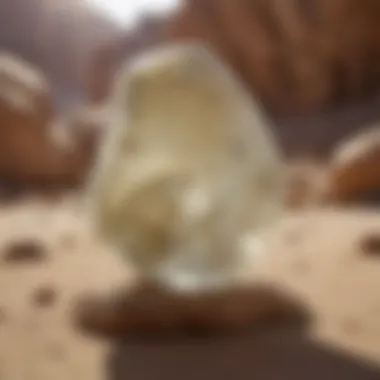
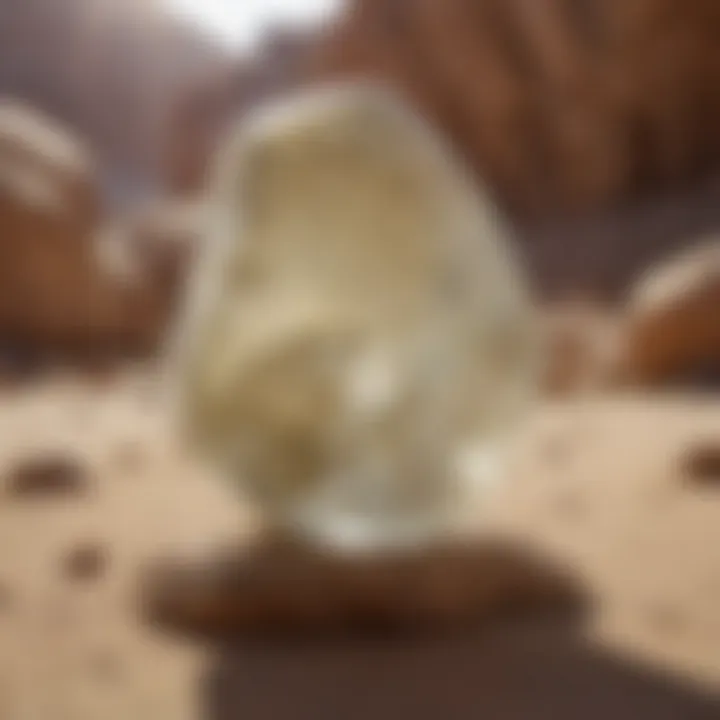
- Key Characteristic: The glass can reflect light beautifully, enhancing the ambiance of a room.
- Benefits: Using Libyan Desert Glass in home decor often signifies a preference for sustainable and unique materials, resonating with eco-conscious consumers.
- Unique Feature: Each piece possesses different textures and shades, adding character to your living space.
The potential disadvantage of using Libyan Desert Glass in home decor is its brittleness. Care is necessary to ensure that these pieces are not easily chipped or broken, which could compromise their integrity and visual appeal.
Industrial Applications
Manufacturing Glass Products
Libyan Desert Glass plays a role in manufacturing unique glass products. Its silica content makes it suitable for creating specialty glass items. Companies are beginning to explore its potential, as it offers properties distinct from conventional glass materials.
- Key Characteristic: The high purity silica provides clarity that can surpass traditional glass.
- Benefits: Utilizing Libyan Desert Glass can lead to the production of products that stand out in clarity and elegance.
- Unique Feature: When combined with different materials, it can yield innovative designs in glassware and art installations.
However, the main challenge remains sourcing sufficient quantities for industrial use. This limits production capabilities and may affect pricing.
Research into Material Properties
Research into the material properties of Libyan Desert Glass opens many avenues for innovation. Scientists study its unique characteristics to better understand its formation and potential applications. Ongoing research might reveal new uses in various fields, including material science and engineering.
- Key Characteristic: Its response to heat and pressure is of great interest.
- Benefits: Knowledge gained could lead to advancements in creating stronger, lighter materials for engineering applications.
- Unique Feature: This research offers insights not just into Libyan Desert Glass, but also into geological processes, enhancing education and scientific understanding.
Yet, the challenge is in securing funding for extensive research. The necessity of specialized equipment may also present obstacles.
Understanding these contemporary uses of Libyan Desert Glass highlights its versatility and significance beyond its geological origins. Its attractiveness in various fields reaffirms the importance of preserving this unique resource.
Research and Future Directions
Ongoing research into Libyan Desert Glass continues to be vital for expanding our understanding of this unique geological material. The study of this natural glass is not limited to its formation and physical properties; it also extends to its broader implications in various scientific fields. By looking at current studies and possible future discoveries, researchers can provide insights that affect geology, archaeology, and technology.
Current Studies
Geochemical Analysis
Geochemical analysis examines the chemical composition of Libyan Desert Glass, helping scientists determine its origins and formation processes. This method is notable for its ability to reveal the elemental and isotopic makeup of the glass. By understanding these components, researchers can link specific geochemical signatures to potential source events, whether from impact phenomena or volcanic activity. This form of analysis is beneficial because it allows for the identification of unique markers that could answer pressing questions about the history of natural glass formation.
Key Characteristics of Geochemical Analysis:
- Allows detailed insight into elemental and isotopic composition.
- Establishes connections to geological events.
However, geochemical analysis does face some disadvantages, such as the complexity of laboratory equipment and the skill required to interpret results effectively. These factors can slow progress, but the technological advancements are making it an increasingly viable method in studies.
Historical Research
Historical research focuses on the archaeological records related to Libyan Desert Glass. This type of research uncovers how ancient civilizations utilized the glass and its significance in cultural practices. By investigating archaeological findings, researchers can understand the importance of Libyan Desert Glass in trade, tool-making, and ceremonial uses.
Key Characteristics of Historical Research:
- Provides context about historical uses of the glass.
- Highlights symbolic meanings in different cultures.
A unique aspect of historical research is its ability to connect past human behavior with geological materials. Nonetheless, challenges arise from the fragmented nature of historical evidence. Access to significant sites can be limited, which sometimes leads to gaps in research findings.
Potential Discoveries
New Formation Theories
New formation theories aim to revise our understanding of how Libyan Desert Glass comes about. The current dominant theories primarily focus on impact and volcanic activities. However, researchers are exploring alternative ideas, including the effects of extreme heat and pressure in ancient lithosphere compositions. Understanding these new theories could reshape our concept of formation processes and pave the way for future studies.
Key Characteristics of New Formation Theories:
- Challenges existing explanations of glass formation.
- Encourages interdisciplinary approaches.
Different potential theories can offer a more holistic understanding of Libyan Desert Glass, but they also require rigorous data collection and testing. The complexity involved can be a barrier to quick acceptance within the scientific community.
Applications in Technology
Applications in technology present exciting possibilities for utilizing Libyan Desert Glass's unique properties. Researchers are investigating its material characteristics to develop innovative solutions in various sectors, from electronics to optics. For instance, its thermal stability and transparency make it a compelling candidate for advancing technology in high-performance materials.
Key Characteristics of Applications in Technology:
- Explores modern uses beyond traditional contexts.
- Connects geology with engineering.
However, while promising, the transition from research to practical application can take time due to material sourcing and the establishment of necessary industrial processes. The potential benefits can justify the investment but require persistent effort and collaboration among various fields.
Ending
The examination of Libyan Desert Glass offers a significant lens into not only geological processes but also cultural heritage. This article dissects the intricate details surrounding this natural glass, from its formation to its applications today. Understanding such elements is crucial for both geologists and collectors.
Summary of Key Insights
Key aspects of Libyan Desert Glass include its formation through extraordinary geological events, notably impact or volcanic activity. Its unique physical characteristics further distinguish it, ranging from its distinct colors to variable transparency levels. Crucial insights into its archaeological significance reveal how ancient civilizations valued this material for practical and symbolic uses. Additionally, the ethical considerations present in collecting underline the importance of respectful practices in safeguarding these natural treasures.
Understanding these elements allows for a deeper appreciation of the geological marvel that Libyan Desert Glass represents. This is not just a commodity for collectors; it is a marker of natural history.
Encouragement for Further Exploration
Collectors and enthusiasts are encouraged to delve deeper into the fascinating world of Libyan Desert Glass. Continued research might unearth new formation theories, or perhaps novel methods of harnessing its unique material properties can emerge. Local geology, preservation techniques, and archaeological findings remain rich fields for exploration.
Exploring the depths of its history and applications can enhance one’s understanding, fostering a greater connection to both the earth and human heritage. The story of Libyan Desert Glass is one of not only its aesthetic but its enduring scientific relevance. Engaging with this material means contributing to a broader narrative that intertwines earth sciences, history, and artistry.



